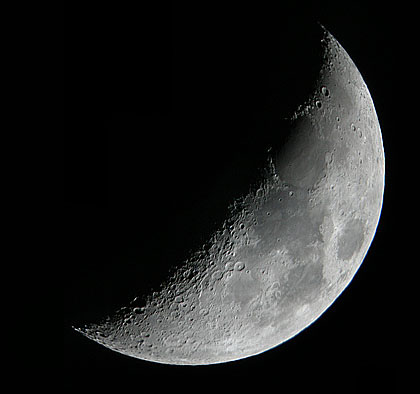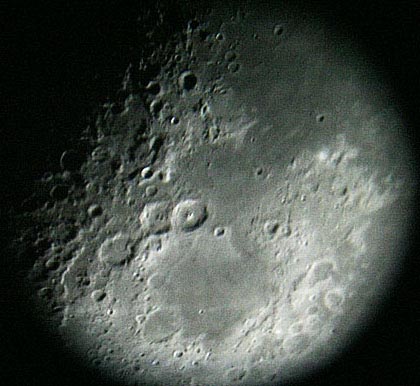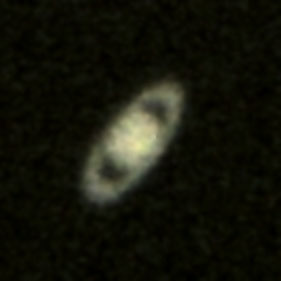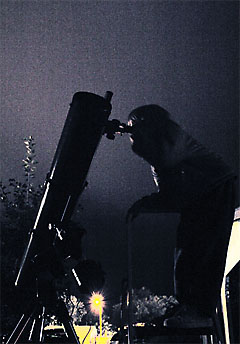After a few days of aggravating monsoonal cloud bathings, things cleared up and I finally got a great viewing session in this past weekend.
I got started Saturday night at about 8 pm and got my first look at the moon with the telescope. The brilliant hugeness of it was like a slap in the face. There was such unbelievable detail in craters. It was so bright it almost hurt. It was still a crescent just shy of its first quarter. My two kids (age 7 and 4), were both thrilled to see it. The craters on the terminator are so dark that my daughter (the 7 year old) was under the impression that they went all the way through the moon to the other side. "You would fall all the way into space if you fell in one of those!" I got some basic handheld pictures through the eyepiece. They seemed to turn out pretty good for not using a camera mount. Here's one I stitched together from 3 pictures. (I couldn't fit the whole thing in one shot.)

This is one taken through the 10 mm eyepiece.

The peculiar guy who walks his dog down the street all the time stopped and took a look and asked questions about stars, the milky way, and Lowell Observatory. "oh yes, the Clark telescope at Lowell Observatory is much bigger than mine..." eheh.
I found M11 again and showed it to my daughter. She could make it out, and thought it was cool. But she was still pretty interested in playing jailhouse warden games with her brother and the red flashlight. After looking at the cluster for a while, I decided I could actually see the loose shape of a duck taking off from the water...thus "Wild Duck Cluster" I guess. I also see faces in tortillas and clouds of smoke.
Next, I started scrolling South down the Milky Way, and found two fuzzies. The first was just south & slightly east of M11. I sketched the stars around it, and best I can figure, it's NGC 6712. As I was sketching it, a satellite cruised right through my view, which I thought was pretty cool (although I probably wouldn't think it was cool if I was in the middle of imaging a long exposure in that area). I haven't been able to figure out what the second fuzzball was. It was much further south. I couldn't make out more than a circular diffuseness on either one, especially due to all the glaring lights everywhere.
I ended up getting Giselle interested in the idea of sketching the layout of stars for later research. "We could be like scientists," she said, "and then go in and check what we found!" She sketched some stars she wanted to identify. But I'm beginning to discover this is difficult when the reference stars are all pretty dim, and blend in with everything else when I check ze charts.
The kids came in, and I decided I wanted to hunt for Neptune and Uranus, since they sit there and taunt me every time I open that Sky program. So I started with Neptune, even though it's the dimmest, because it's right next to a star in Capricornus. I figured that would make it easy, but it turned out to be pretty stinking hard for me. The star, Theta Capricorni, was difficult to find in the spotter scope. My confidence that I had even the right reference star was low enough that I sketched the vicinity, and the object I thought might be Neptune. And then I'll try to revisit it later and see if its position changes. It did appear to be blue-green...but that might just be my wishful thinking. Anyway, I'll see what happens....it looks that giving it a week or two would be enough to see a noticable change.
My next stop was Uranus. While it is brighter, it's also not next to a prominent constellation star. I used an imaginary line from a star in Aquarius (Lambda Aquarii) to a star in Capricornus (Delta Capricorni) and looked about a third of the way over from Aquarius. In this case, Uranus was supposed to be bounded very neatly by 4 bright stars including Sigma Aquarii. And there it was. I saw Uranus! It was ever so slightly greenish. And what's more, when I put in the 10 mm eyepiece, it wasn't a point of light anymore. It was a thick little dot. I checked my focus on the nearby stars to be sure I wasn't fooling myself, and they were all reasonably pointy points, but my planetary catch was a thick dot. MAN that's cool! I sketched it's position, compared to imaginary bisecting lines in the square of stars just to revisit later and double-check that it moved, but I'm positive that was it.
After that personal victory, I did some pleasure viewing of the Pleiades, and then Andromeda, before doing some window shopping starting in the Milky Way at Casseopeia. I just started looking for fuzziness in the spotting scope. And easily ran into 4 different DSOs. I sketched what I saw and referenced their position in the Milky Way relative to Cassiopeia, the Pleiades, and Auriga for checking later.
The first one was a beautifully obvious double-cluster northeast of Cassiopeia. It had a cool string of stars trailing away from it like a cast fishing line. This turned out to be NGC 884 and 869, The Double Cluster in Perseus. Awesome. I'll be coming back to this one again soon™.
After grinning over that, I moved on and found another cluster near Lamba Persei. It was a bit looser than M11 or the double cluster. My sketch matched closely to NGC 1528 and I'm pretty sure that was it (there's two rows of three brighter stars in the middle).
The next patch I ran into was just inside Auriga, next to Iota Aurigae. It was another loose cluster when I checked it in the 25 mm eyepiece. My sketch matched up to M36,
My last stop was a rich cluster of stars just outside of Auriga, near Theta Aurigae. This one is dense like M11, and I had to sketch it with a rough outline, and then mark some main stars inside and out. It matched up to M37 in position and general configuration.
As I was writing this up, and checking the photographs I had taken, time passed quickly, and before I knew it, it was 4 am. So of course I popped outside and sure enough, Orion, Venus and Saturn were out. I took the telescope back outside and lined up on Venus first. With the 10 mm eyepiece, it was an incredibly brilliant half circle. In fact it was so bright, it was throwing flare all over the lens. Still, this was the first time I had seen Venus in anything other than binoculars, and it was impressive.
My next stop was Orion's belt. This was unbelievable. The M42 nebula is immense, bright, and peppered with hot stars. I could make out dust lanes and more detail than I thought I could from this spot (the neighbor's steenking driveway lights were still on :P ). Both 48X and 120X magnifications of the nebula were bright and clear. This will definitely be one of my first DSO pictures when I get set up for long exposures. As if that's an unusual first goal ;-)
Finally, I turned over to Saturn, which was glowing a soft ivory below Venus. 120X magnification showed the rings distinctly, but no Cassini division. Here's a crummy, noisy, blurry handheld stacking of 5 shots for whatever it's worth:

I swear, it looked better than that. But shaky handheld snapshots of a planet quivering on the horizon aren't going to cut it I guess :-)
So my tally for the night: M11 (reprise), NGC 6712 (probably), M31 (reprise), M45 (reprise), NGC 884, NGC 869, NGC 1528, M36, M37, M42, M43, Neptune (probably), Uranus, Venus, Saturn and the moon.
This was great. I can't imagine what things would look like at a dark site. And I'm also looking forward to getting the UPS packages containing the polar alignment scope, t-ring, camera mount and 2x Ultima Barlow so I can practice putting a shine...or at least a rough sanding on these beauties in the sky.
Hmmmm...it probably wouldn't hurt to spend a couple bucks on a notebook instead of tucking all these loose sketch sheets around my desk.





